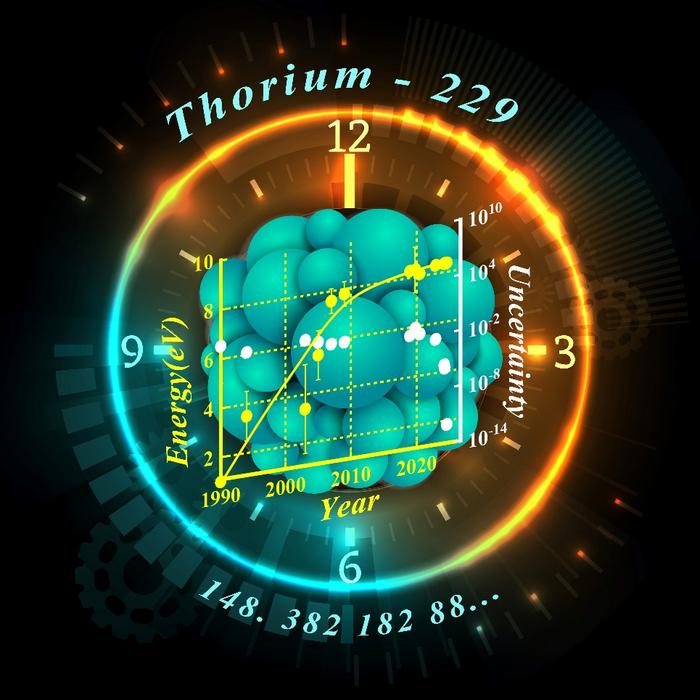In a groundbreaking exploration published in the respected journal, National Science Review, a team led by Dr. Xin Tong from the Innovation Academy for Precision Measurement Science and Technology at the Chinese Academy of Sciences has illuminated the vast potential of the thorium-229 (Th-229) nuclear optical clock. This perspective article highlights not only the promise of this innovative timekeeping technology but also delves deeply into the scientific challenges and future implications that are pivotal for advancing our understanding of time itself.
At the core of the discussion is the concept of precision measurements related to time and frequency, which are arguably the most precisely quantifiable physical quantities known to science. In the contemporary milieu of atomic clocks, particularly those utilizing optical technology, the quest for accuracy seems insatiable. However, the research suggests that the Th-229 nuclear optical clock could redefine this quest, boasting potential precision that far surpasses current atomic clock standards. The emergence of this cutting-edge technology signifies an evolution in our approach to measuring time with unprecedented clarity.
What sets the Th-229 isotope apart from all known nuclides is its unique capability to allow precise laser manipulation of nuclear quantum states. Unlike traditional atomic clocks, where the entire atom is subject to external perturbations, the smaller nuclear scale of Th-229 reduces its susceptibility to environmental shocks. The well-separated nature of nuclear quantum states, combined with protective shielding provided by extranuclear electrons against electromagnetic interference, positions the Th-229 clock as a highly stable and reliable candidate for time measurement. This fundamental difference lays the groundwork for an optical clock whose precision could set new standards in metrology.
The journey of researching Th-229 spans nearly fifty years, culminating in significant breakthroughs that highlight the advancement of our scientific knowledge. Initial identification of the low-lying excited nuclear state of Th-229 marked the inception of this field of study, leading to critical developments that have deepened our understanding of nuclear transitions. In a promising development in 2024, researchers achieved direct laser excitation of the Th-229 nuclear transition, a feat that many had believed would take far longer to realize. This landmark achievement underscores the transformative potential of this research as laboratories worldwide continue to investigate the capabilities of Th-229.
Institutions across the globe, such as Technische Universität (TU) Wien, the University of California at Los Angeles (UCLA), and the Joint Institute for Laboratory Astrophysics (JILA), have engaged in groundbreaking experiments employing diverse materials like doped crystals and thin films. These efforts have improved measurement techniques and have gradually enhanced the scientific community’s understanding of the intricate mechanisms governing nuclear transitions. Although progress has been substantial, the journey remains fraught with challenges that demand innovative solutions.
Among the most pressing challenges researchers face is the sensitivity of nuclear transitions to thermal fluctuations within solid-state environments. The coveted Th-229 isotope is notably scarce, posing practical limitations on experimental endeavors. Additionally, the development of a high-power, narrow-linewidth laser specifically tailored for this type of clock has proven to be a formidable hurdle. The incomplete comprehension of interaction mechanisms further complicates the pursuit of reliable results, illustrating the complexities that underpin this advanced technology.
Despite these obstacles, the urgency to advance the field cannot be overstated. Realizing the functionality of the thorium nuclear clock promises to revolutionize our understanding and practical application of timekeeping. The implications extend beyond mere precision; this advancement could incite a paradigm shift in optical clock systems, moving away from reliance on electronic transitions towards harnessing the unique characteristics of nuclear transitions. Such a shift opens avenues for deeper exploration into fundamental physical laws and could catalyze innovations in various scientific disciplines, including quantum mechanics and fundamental physics.
Groundbreaking technologies often come with high expectations, and the Th-229 nuclear optical clock is no exception. The scientific community anticipates not only potential enhancements in timing precision but also transformative impacts on GPS technology, telecommunications, and financial systems. The implications for scientific research and exploration are equally profound, as the ability to measure time with greater accuracy could lead to significant breakthroughs in areas such as cosmology and high-energy physics.
As researchers continue to overcome the myriad challenges associated with the Th-229 nuclear optical clock, the path ahead is laden with opportunities for innovation and discovery. The collective efforts of scientists across continents depict a collaborative spirit dedicated to pushing the boundaries of knowledge in precision measurement. The journey, marked by persistence and determination, is driving a new narrative in the quest for understanding time.
Moreover, the potential applications of this technology reach beyond traditional metrics of time. The development of instruments capable of nuclear timekeeping may allow researchers to unlock new avenues for experimentation, leading to discoveries that were previously unimaginable. As we stand on the brink of this new frontier, the scientific community’s curiosity is as fervent as ever, navigating the challenges with unyielding resolve.
In conclusion, the development of the thorium-229 nuclear optical clock heralds a new era in timekeeping technology. With the potential for unmatched precision and a multitude of applications, researchers are energized by the endeavor to bring this concept to fruition. As the world of science continues to unveil the intricacies of time, this innovative clock promises to alter our perception and understanding of this most fundamental measurement, offering a new lens through which to view our universe.
Subject of Research: Thorium-229 Nuclear Optical Clock
Article Title: The Promise of the Thorium-229 Nuclear Optical Clock
News Publication Date: October 2023
Web References: National Science Review
References: National Science Review, research articles pertaining to Th-229 and optical clocks
Image Credits: Yuan Zou
Keywords: Thorium-229, Nuclear Optical Clock, Precision Measurement, Atomic Clocks, Timekeeping Technologies, Nuclear Quantum States, Science Innovations, Fundamental Physics, Research Challenges, Technological Advancements, Time Measurement, Scientific Collaboration.




